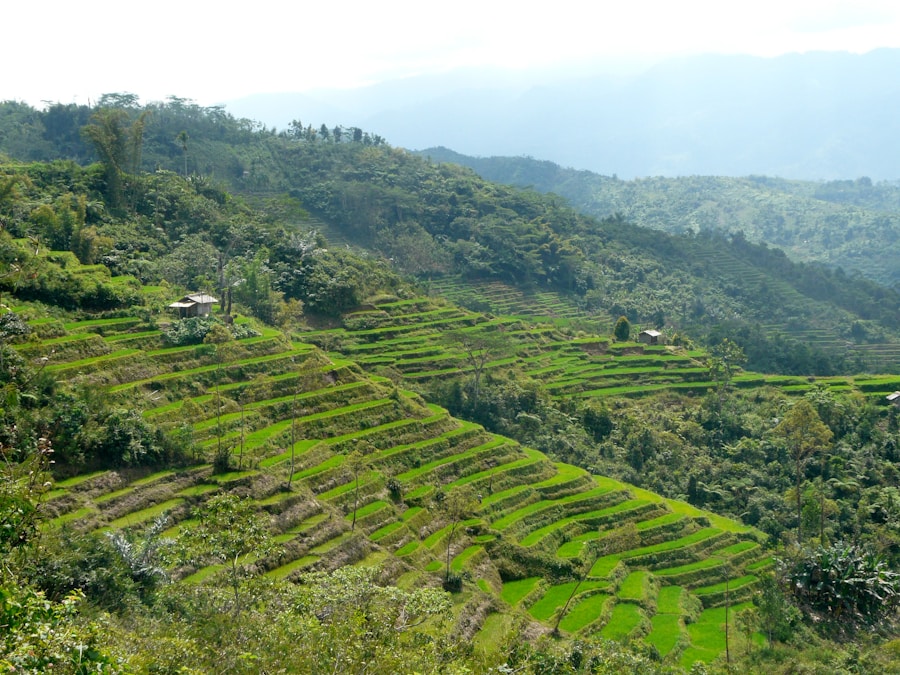Download links
How to install Preserving the 30jili Banaue Rice Terraces APK?
1. Tap the downloaded Preserving the 30jili Banaue Rice Terraces APK file.
2. Touch install.
3. Follow the steps on the screen.
Description
The Banaue Rice Terraces, often referred to as the “Eighth Wonder of the World,” are a remarkable feat of engineering and agriculture that date back over 2,000 years. Located in the mountainous region of Ifugao in the Philippines, these terraces were carved into the mountainsides by the indigenous Ifugao people. The construction of these terraces is not merely a testament to human ingenuity but also reflects a deep understanding of sustainable agricultural practices and environmental stewardship.
The terraces are an intricate system of irrigation and cultivation that has allowed the Ifugao to thrive in a challenging landscape, showcasing their ability to adapt to and harmonize with their environment. Historically, the Banaue Rice Terraces are significant not only for their agricultural output but also for their cultural importance. They are a living testament to the Ifugao’s rich heritage, embodying their traditions, beliefs, and social structures.
The terraces are interwoven with the community’s rituals and practices, such as the rice planting and harvesting festivals, which celebrate the connection between the people and their land. This cultural landscape has been recognized by UNESCO as a World Heritage Site, underscoring its global significance and the need for its preservation. The terraces serve as a symbol of resilience and ingenuity, representing a way of life that has persisted through centuries of change.
Key Takeaways
- The Banaue Rice Terraces are an important historical and cultural landmark, dating back over 2,000 years.
- Threats to the preservation of the Banaue Rice Terraces include environmental degradation, urbanization, and a lack of sustainable farming practices.
- Efforts to preserve and protect the Banaue Rice Terraces include UNESCO World Heritage designation, community-based conservation initiatives, and sustainable tourism development.
- Sustainable agriculture is crucial for preserving the Banaue Rice Terraces, as it helps maintain the ecological balance and traditional farming methods.
- Indigenous communities play a vital role in preserving the Banaue Rice Terraces through their traditional knowledge, cultural practices, and stewardship of the land.
The Threats to the Preservation of the Banaue Rice Terraces
Despite their historical and cultural significance, the Banaue Rice Terraces face numerous threats that jeopardize their preservation. One of the most pressing issues is climate change, which has led to unpredictable weather patterns, including prolonged droughts and intense rainfall. These climatic shifts can cause soil erosion, landslides, and damage to the intricate irrigation systems that are vital for maintaining the terraces.
As rainfall becomes more erratic, the delicate balance that sustains rice cultivation in these terraces is increasingly at risk, threatening not only agricultural productivity but also the very structure of the terraces themselves. In addition to climate change, modernization poses a significant threat to the traditional practices that have sustained the Banaue Rice Terraces for generations. The younger generation is increasingly drawn to urban areas in search of better economic opportunities, leading to a decline in agricultural labor within the terraces.
This migration results in abandoned fields and a loss of traditional knowledge related to rice cultivation and terrace maintenance. Furthermore, the encroachment of commercial agriculture and tourism development can lead to land degradation and further erosion of cultural practices. The combination of these factors creates a precarious situation for the future of the terraces, as they struggle to adapt to both environmental changes and socio-economic pressures.
Efforts to Preserve and Protect the Banaue Rice Terraces

Recognizing the urgent need for preservation, various stakeholders have initiated efforts to protect the Banaue Rice Terraces from further degradation. Local government units, non-governmental organizations (NGOs), and community groups have come together to implement conservation programs aimed at restoring and maintaining these historic landscapes. One notable initiative is the establishment of sustainable farming practices that align with traditional methods while incorporating modern techniques.
These practices not only enhance productivity but also promote environmental sustainability by reducing chemical inputs and preserving soil health. Education plays a crucial role in these preservation efforts. Programs aimed at raising awareness among local communities about the importance of maintaining the terraces have been developed.
Workshops and training sessions focus on traditional agricultural techniques, environmental conservation, and the cultural significance of the rice terraces. By empowering local farmers with knowledge and skills, these initiatives aim to foster a sense of pride in their heritage and encourage active participation in preservation efforts. Additionally, partnerships with academic institutions have facilitated research on sustainable agricultural practices that can be adapted to local conditions, further supporting the long-term viability of the terraces.
The Importance of Sustainable Agriculture in Preserving the Banaue Rice Terraces
| Metrics | Data |
|---|---|
| Land Area of Banaue Rice Terraces | 10,360 square kilometers |
| Number of Rice Terraces | over 2,000 |
| Age of Banaue Rice Terraces | over 2,000 years old |
| Importance of Sustainable Agriculture | Preserves the terraces for future generations |
| Impact of Climate Change | Threatens the stability of the terraces |
Sustainable agriculture is pivotal in ensuring the longevity of the Banaue Rice Terraces. The traditional farming methods employed by the Ifugao people are inherently sustainable, relying on organic practices that have been honed over centuries. These methods include crop rotation, intercropping, and natural pest management, which not only enhance biodiversity but also maintain soil fertility.
By prioritizing sustainable practices, farmers can mitigate some of the adverse effects of climate change while preserving the ecological integrity of their environment. Moreover, sustainable agriculture contributes to food security for local communities. The rice produced in the terraces is not only a staple food but also a cultural symbol that reinforces community identity.
By promoting local consumption and reducing reliance on imported goods, sustainable agriculture helps strengthen local economies and fosters resilience against external shocks. Initiatives that support organic farming certification can also open up new markets for Ifugao rice, providing farmers with additional income while encouraging them to maintain their traditional practices. This holistic approach ensures that agriculture remains viable while safeguarding the cultural heritage embodied in the Banaue Rice Terraces.
The Role of Indigenous Communities in Preserving the Banaue Rice Terraces
Indigenous communities play an indispensable role in preserving the Banaue Rice Terraces.
This knowledge is not merely practical; it is deeply intertwined with their cultural identity and spiritual beliefs.
The Ifugao view their relationship with the land as sacred, which motivates them to protect and sustain their agricultural heritage. Community-led initiatives are crucial for effective preservation efforts. Local organizations have emerged to advocate for indigenous rights and promote sustainable practices that align with traditional values.
These groups often engage in collaborative projects that involve replanting abandoned terraces, restoring irrigation systems, and revitalizing traditional farming techniques. By fostering community involvement and leadership, these initiatives empower indigenous peoples to take ownership of their heritage while ensuring that their voices are heard in discussions about land use and conservation policies. The active participation of indigenous communities is essential for creating a sustainable future for the Banaue Rice Terraces.
The Future of the 30jili Banaue Rice Terraces and Its Preservation Efforts

Adapting to Climate Change
As climate change continues to pose challenges, ongoing research into adaptive agricultural practices will be vital for ensuring resilience in rice production. Innovations such as drought-resistant rice varieties or improved water management techniques can help mitigate some of the impacts of changing weather patterns while preserving traditional farming methods.
Responsible Tourism for Preservation
Furthermore, fostering tourism that respects and supports local culture can provide economic incentives for preservation. Responsible tourism initiatives can create opportunities for visitors to learn about Ifugao culture while contributing to local economies through eco-friendly practices. By promoting cultural heritage tourism that emphasizes education and community involvement, stakeholders can generate revenue that directly supports conservation efforts.
A Collaborative Effort for Preservation
Ultimately, preserving the Banaue Rice Terraces requires a collaborative effort among local communities, government agencies, NGOs, and academic institutions. By recognizing the interconnectedness of cultural heritage, environmental sustainability, and economic viability, stakeholders can work together to ensure that this extraordinary landscape continues to thrive for future generations. The legacy of the Banaue Rice Terraces is not just about preserving an ancient agricultural system; it is about honoring a way of life that embodies resilience, ingenuity, and respect for nature.
FAQs
What are the Banaue Rice Terraces?
The Banaue Rice Terraces are ancient terraces carved into the mountains of Ifugao in the Philippines. They are often referred to as the “Eighth Wonder of the World” and are a UNESCO World Heritage Site.
How old are the Banaue Rice Terraces?
The Banaue Rice Terraces are estimated to be over 2,000 years old, making them one of the oldest and most remarkable examples of terrace farming in the world.
What is the significance of the Banaue Rice Terraces?
The terraces are not only a stunning feat of engineering and agriculture, but they also hold cultural and historical significance for the indigenous people of the region. They are a symbol of the ingenuity and sustainable farming practices of the Ifugao people.
How were the Banaue Rice Terraces built?
The terraces were built by hand, with the Ifugao people using minimal tools and primarily relying on their knowledge of the land and natural resources. The construction of the terraces involved carving into the mountainside and creating a system of irrigation to support rice cultivation.
Can visitors explore the Banaue Rice Terraces?
Yes, visitors are welcome to explore the Banaue Rice Terraces. There are hiking trails and viewpoints that offer breathtaking vistas of the terraces, allowing visitors to appreciate their beauty and learn about their history and significance.





